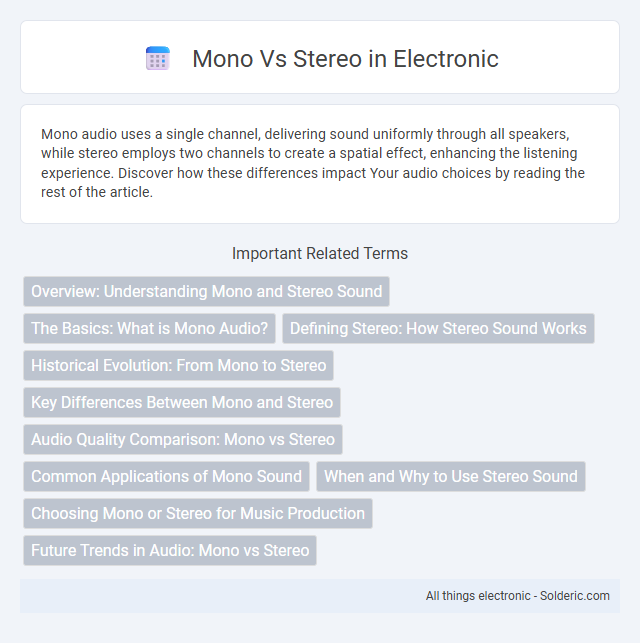Mono audio uses a single channel, delivering sound uniformly through all speakers, while stereo employs two channels to create a spatial effect, enhancing the listening experience. Discover how these differences impact Your audio choices by reading the rest of the article.
Comparison Table
| Aspect | Mono | Stereo |
|---|---|---|
| Channels | Single audio channel | Two separate audio channels (left and right) |
| Sound Source | Mixed audio into one channel | Independent left and right audio sources |
| Audio Depth | Flat sound image | Spacial and directional sound perception |
| Use Cases | Telephony, voice recordings, AM radio | Music, movies, modern broadcasting |
| File Size | Smaller file size | Larger file size due to dual channels |
| Compatibility | Works on all playback systems | Requires stereo-capable devices for full effect |
| Audio Quality | Basic, less immersive | Rich, immersive listening experience |
Overview: Understanding Mono and Stereo Sound
Mono sound utilizes a single audio channel, delivering the same signal to all speakers, which simplifies sound reproduction and is ideal for clear voice recording or environments with limited speaker setups. Stereo sound employs two separate audio channels, creating a sense of spatial dimension and directionality by distributing different audio signals to the left and right speakers, enhancing the listening experience with depth and realism. Your choice between mono and stereo depends on the desired audio clarity versus immersive soundstage for music, film, or communication purposes.
The Basics: What is Mono Audio?
Mono audio delivers sound through a single channel, meaning all audio signals are combined and played back uniformly from one source. This creates a centered sound experience where You hear the same audio regardless of your listening position or speaker setup. Mono is often used in communication devices and simple audio systems to ensure clear and consistent sound.
Defining Stereo: How Stereo Sound Works
Stereo sound uses two separate audio channels to create a sense of spatial depth and direction, delivering a more immersive listening experience compared to mono. By playing different audio signals through the left and right speakers, stereo sound mimics natural hearing, allowing your brain to perceive sound positioning and distance. This technique enhances music, movies, and games by providing clear separation between instruments, voices, and environmental sounds.
Historical Evolution: From Mono to Stereo
The historical evolution from mono to stereo marked a pivotal advancement in audio technology, beginning with mono's single-channel sound reproduction dominating early radio and vinyl records in the 1930s. Stereo sound emerged in the late 1950s, offering two separate audio channels that created a spatial, immersive listening experience by simulating natural hearing. Your transition to stereo systems revolutionized music production and consumption, enhancing sound clarity and depth, which reshaped the entertainment and broadcasting industries.
Key Differences Between Mono and Stereo
Mono audio uses a single channel to deliver sound, creating a uniform audio experience regardless of listener position, whereas stereo audio employs two separate channels to produce a more immersive and spatial sound environment with distinct left and right audio inputs. In recording and playback, mono mixes all audio signals into one track, ideal for clarity and compatibility, while stereo maintains discrete audio streams, enhancing depth and directionality for music, films, and gaming. The choice between mono and stereo affects audio fidelity, spatial perception, and listener engagement based on the intended use case and playback equipment.
Audio Quality Comparison: Mono vs Stereo
Mono audio delivers sound through a single channel, resulting in a unified and focused auditory experience that is ideal for voice clarity and consistent playback across all devices. Stereo audio uses two separate channels to create a sense of spatial dimension and depth, enhancing music and sound effects with a more immersive and dynamic quality. While stereo offers richer and more realistic soundscapes, mono ensures uniform audio reproduction, especially in environments with limited speaker setups or when consistent sound is crucial.
Common Applications of Mono Sound
Mono sound is widely used in telephone communications, public address systems, and AM radio broadcasting due to its simplicity and consistent audio quality regardless of playback device. It is also commonly applied in podcasting and voice recording where clarity of the spoken word is prioritized over spatial audio effects. This single-channel audio format ensures compatibility across various platforms and reduces production complexity.
When and Why to Use Stereo Sound
Stereo sound enhances audio depth and spatial awareness by using two distinct channels, creating a more immersive listening experience ideal for music, movies, and gaming. You should use stereo sound when you want to capture the full ambiance or directionality of audio sources, such as instruments in music production or environmental sounds in film. Stereo's ability to simulate real-life audio positioning helps improve clarity and engagement in multimedia content.
Choosing Mono or Stereo for Music Production
Choosing mono or stereo for music production depends on the desired spatial effect and mix clarity. Mono is ideal for elements requiring focus and punch, such as vocals and bass, ensuring consistent playback across all devices. Stereo offers a wider soundstage with panning options, enhancing depth and immersion for instruments and effects within the mix.
Future Trends in Audio: Mono vs Stereo
Future trends in audio emphasize immersive experiences with a growing preference for stereo and spatial sound technologies, enhancing depth and directionality beyond traditional mono formats. Advances in spatial audio, binaural recording, and 3D sound processing are shaping consumer expectations, especially for virtual reality, gaming, and streaming services. Despite this, mono audio remains relevant for voice clarity and compatibility in smart devices and broadcast media.
Mono vs Stereo Infographic

 solderic.com
solderic.com